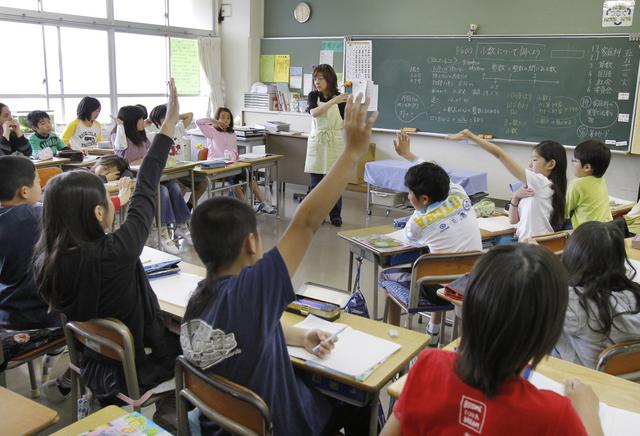일본의 위기감이 초등학교 교실에도 불어닥쳤다.
한국 등 경쟁국 어린이들에 뒤처지자(fall behind the children in rivals such as Korea) 초등학교 교과서를 1200쪽가량 늘리기로(add about 1200 pages to elementary school testbooks) 한 것이다.
일본 요코하마 혼모쿠초등학교의 산수수업 모습 
이에 따라 6년 과정 모든 과목 교과서들(the textbooks across all subjects for six years of elementary school)은 총 4900쪽에서 6100쪽으로 늘어나게(go up to 6100) 된다. 과학과 수학은 60%나 분량이 늘어나고, 5학년부터는 영어 과목이 도입된다(be introduced in fifth grade).
기계적 암기를 줄이고 지식 응용을 고무하기(encourage more application of knowledge and less rote memorization) 위해 시행해온 10년간의 ‘유도리(압박 없는)교육’(a 10-year experiment in ‘pressure-free education’)은 원점으로 돌아가게(go back to basics) 됐다.
유도리 교육으로 교과 내용이 줄어들고, 토요일 반일 수업(Saturday half-day classes)은 폐지되는(be phased out) 등 학습 부담이 크게 줄었었다.
그러나 국제표준화테스트에서 1위에 가까웠던 일본의 순위(Japan’s near-the-top rank on international standardized tests)가 추락을 거듭, 교육이 오랫동안 자랑거리였던(have long been a source of pride) 이 나라를 망연자실하게(stun this nation) 했다.
수학은 2000년 1위에서 2006년 10위로 떨어졌고(drop from first in 2000 to 10th in 2006), 과학은 2위에서 6위로 추락했다(slide from second to 6th). 독해력은 8위에서 15위로 하락(decline from 8th to 15th)했다.
교육 논란은 더욱 깊어진 일본의 불안감을 반영하는(reflect a deeper anxiety of Japan) 것이다. 한때 대단했으나 지금은 침체된 경제(the once-powerful and now stagnant economy)는 중국 경제에 추월당했고(be overtaken by China’s), 늘어나는 재정적자와 노령화·감소세 인구문제 해결에 쩔쩔매고(grapple with how to deal with a bulging fiscal deficit and an aging, shrinking population) 있어 위기감(a sense of crisis)을 더하고 있다.
그러나 반대론자들은 현재의 시스템이 결실을 보기 위해선 더 많은 시간이 필요하다고(need more time to bear fruit) 반박한다. 교과서 페이지를 늘리고(add pages to textbooks) 더 많은 암기를 밀어붙인다고(push for more memorization) 해서 나아질 것이 없다는 것이다.
‘주입식 교육’으로의 회귀(a return to the ‘cram education’)는 과거로부터 벗어나야 하는(need to break away from the past) 미래 세대들을 망치고 말 것이라고 주장한다.